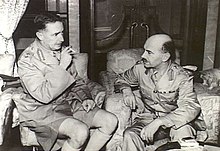John K. Lawson
John Kelburne Lawson (27 December 1886 – 19 December 1941) was a Canadian military officer who served as commander of the West Brigade during the Battle of Hong Kong. A brigadier, he was the most senior officer to be killed in action during the battle, and the highest-ranking Canadian soldier killed in action in the Second World War.[1]
John Kelburne Lawson | |
|---|---|
 Brigadier John K. Lawson (right) with General Christopher Maltby | |
| Born | 27 December 1886 Hull, England |
| Died | 19 December 1941 (aged 54) British Hong Kong |
| Buried | |
| Allegiance | Canada |
| Service/ | Canadian Army |
| Years of service | 1914–1941 |
| Rank | Brigadier |
| Commands held | C Force |
| Battles/wars | World War I |
| Awards | Croix de guerre |
Early career
Lawson was born in Hull, East Riding of Yorkshire. He emigrated to Edmonton in 1914 where he worked as a clerk for the Hudson's Bay Company. He enlisted in the Canadian Expeditionary Force (CEF) upon the outbreak of the First World War. He joined the 9th Battalion, CEF, and variously worked at the 1st Canadian Motor Machine Gun Brigade and at Corps Headquarters. Although he is often incorrectly attributed a Military Cross for actions at the Battle of Passchendaele or the Battle of the Somme, he was twice mentioned in despatches and received the French Croix de guerre. Lawson joined as a private in 1914 and rose to the rank of warrant officer first class before commissioning. He held the rank of captain at the end of the war.[2]
Lawson joined the Permanent Active Militia during the interwar years. He held various positions in Calgary, Kingston, Toronto, and Ottawa. He completed staff college in Quetta in 1923–1924, and was posted to the War Office in London, England, in 1930.
When the Second World War broke out, he was Director of Military Training in Ottawa. He was given command of the Royal Rifles of Canada, The Winnipeg Grenadiers[1], and the other Canadian support units which arrived in Hong Kong on 16 November 1941 to reinforce the British garrison ahead of the Battle of Hong Kong (8–25 December 1941).
Battle of Hong Kong
After the forces defending Kowloon were withdrawn to the island of Hong Kong on 11 December 1941, General Christopher Maltby organized the defence of the island into two brigades, west and east. Lawson was placed in charge of the west brigade,[1] which included the Winnipeg Grenadiers, the Royal Scots, the Punjab Regiment (India) and the Canadian Signallers. The Japanese landed on Hong Kong Island on 18 December 1941 with the intent to split the defenders in two. After fierce fighting, Japanese forces surrounded Lawson's headquarters at around 10 a.m. on 19 December. Lawson radioed his commanders that he was "going outside to fight it out" and left his pillbox with a pistol in each hand. He was killed in the ensuing fight.[1][3][4]
When the Japanese arrived and found his body, they gave him a military burial nearby in Wong Nai Chong Gap out of respect for his courage. A chaplain was allowed to remove Lawson's silver identification disc bracelet and held on to it through four years as a Japanese prisoner of war before returning it to Lawson's family in Canada. Meanwhile, Hong Kong was relieved only on 16 September 1945, more than a month after the Atomic bombings of Hiroshima and Nagasaki.[5]
Lawson was reburied at the Sai Wan War Cemetery after the war.[1] The original headstone was destroyed and a memorial plate was erected by the Canadian government at the site in 2005.
Personal life
Lawson was married to Augusta Hawkesworth Wilson in 1930 and had two sons, Arthur John (b. 1934) and Michael Ivan (b. 1936).[6]
His family donated his medals to the Royal Canadian Military Institute.
References
- Smith, Craig S. (23 December 2016). "A Doomed Battle for Hong Kong, With Only Medals Left 75 Years Later". The New York Times. Retrieved 3 January 2017.
- Wentzell, Tyler (April 2011). "Brigadier J.K. Lawson and Command of 'C' Force at Hong Kong" (pdf). Canadian Military History. Retrieved 2 February 2015.
- "The Battle of Hong Kong". Canada at War. Retrieved 2 February 2015.
- Churchill, Winston (1950). The Grand Alliance. London. pp. 633.
- Churchill, Winston (1953). Triumph and Tragedy. London. pp. 646.
- "Brigadier John Kelburne Lawson". veterans.gc.ca. Veterans Affairs Canada. 11 September 2019. Retrieved 13 October 2019.
External links
| Wikimedia Commons has media related to John K. Lawson. |